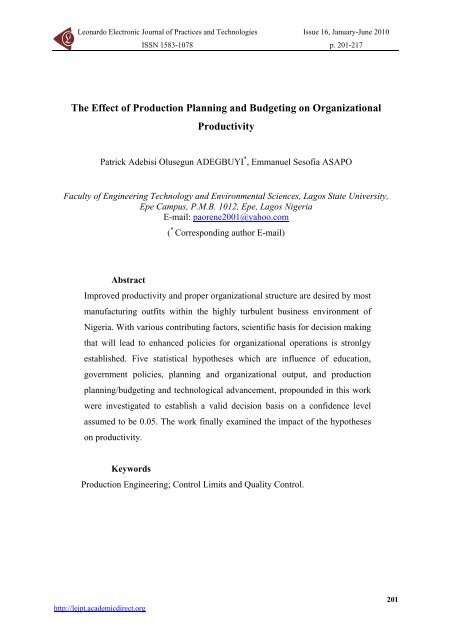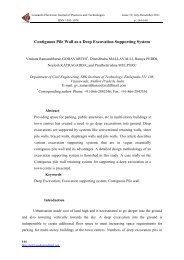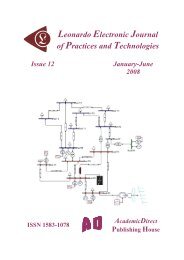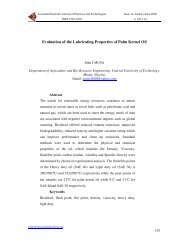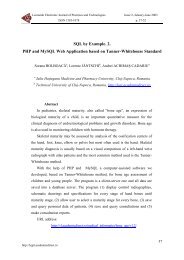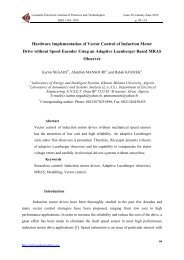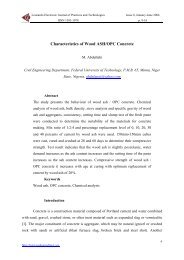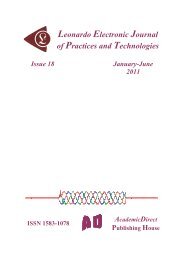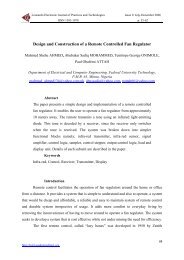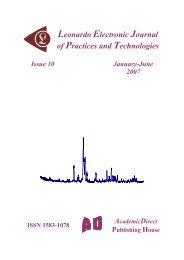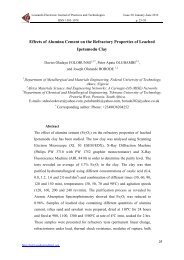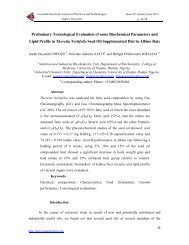View - Leonardo Electronic Journal of Practices and Technologies
View - Leonardo Electronic Journal of Practices and Technologies
View - Leonardo Electronic Journal of Practices and Technologies
Create successful ePaper yourself
Turn your PDF publications into a flip-book with our unique Google optimized e-Paper software.
<strong>Leonardo</strong> <strong>Electronic</strong> <strong>Journal</strong> <strong>of</strong> <strong>Practices</strong> <strong>and</strong> <strong>Technologies</strong><br />
http://lejpt.academicdirect.org<br />
ISSN 1583-1078<br />
Issue 16, January-June 2010<br />
p. 201-217<br />
The Effect <strong>of</strong> Production Planning <strong>and</strong> Budgeting on Organizational<br />
Productivity<br />
Patrick Adebisi Olusegun ADEGBUYI * , Emmanuel Ses<strong>of</strong>ia ASAPO<br />
Faculty <strong>of</strong> Engineering Technology <strong>and</strong> Environmental Sciences, Lagos State University,<br />
Epe Campus, P.M.B. 1012, Epe, Lagos Nigeria<br />
E-mail: paorene2001@yahoo.com<br />
( * Corresponding author E-mail)<br />
Abstract<br />
Improved productivity <strong>and</strong> proper organizational structure are desired by most<br />
manufacturing outfits within the highly turbulent business environment <strong>of</strong><br />
Nigeria. With various contributing factors, scientific basis for decision making<br />
that will lead to enhanced policies for organizational operations is stronlgy<br />
established. Five statistical hypotheses which are influence <strong>of</strong> education,<br />
government policies, planning <strong>and</strong> organizational output, <strong>and</strong> production<br />
planning/budgeting <strong>and</strong> technological advancement, propounded in this work<br />
were investigated to establish a valid decision basis on a confidence level<br />
assumed to be 0.05. The work finally examined the impact <strong>of</strong> the hypotheses<br />
on productivity.<br />
Keywords<br />
Production Engineering; Control Limits <strong>and</strong> Quality Control.<br />
201
202<br />
The Effect <strong>of</strong> Production Planning <strong>and</strong> Budgeting on Organizational Productivity<br />
Introduction<br />
Patrick Adebisi Olusegun ADEGBUYI <strong>and</strong> Emmanuel Ses<strong>of</strong>ia ASAPO<br />
Production management is simply the analysis involved in transforming raw material<br />
or components into finished products, integrated synergistically to reduce waste in time <strong>and</strong><br />
finance with maximum obtainable pr<strong>of</strong>it. With reference to services (intangible), production is<br />
the discharge <strong>of</strong> a function with some degree <strong>of</strong> utility, which for goods (tangible) production<br />
is viewed as the fabrication, interchange <strong>and</strong> re-use <strong>of</strong> physical objects through machines,<br />
human resources <strong>and</strong> any other pertinent applicable tools. The use <strong>of</strong> tools in a concise<br />
approach is referred to as operation which is however broader <strong>and</strong> all encompassing due to its<br />
non-limitation.<br />
In Operations, there is a continuous dearth <strong>of</strong> well-defined, interchange <strong>and</strong> effective<br />
production management due to consistent failure in production variables such as production<br />
operations, budgeting, pr<strong>of</strong>itability <strong>and</strong> technological advancement coupled with competitions<br />
in working environment. The sole objective <strong>of</strong> a production policy is to ensure that products<br />
are supplied in the required volume <strong>of</strong> the required quality at the time required <strong>and</strong> at<br />
affordable minimum cost. This simplistic desire, dem<strong>and</strong>s effective <strong>and</strong> flexible production<br />
planning, in meeting all the requirements in terms <strong>of</strong> resources usage.<br />
Delivery schedules/promises have been broken in many situations with various legal<br />
implications due to wrong capacity assessment, production schedule, internal bureaucracies,<br />
idle time <strong>and</strong> other excess production requirements. For an economical production, there must<br />
be a minimum interruption to flow due to lack <strong>of</strong> work information with balanced work load<br />
between departments.<br />
The objectives <strong>of</strong> production planning can be summarized as follows: provide the<br />
capacity <strong>and</strong> production to meet agreed or projected dem<strong>and</strong>, ensure timely <strong>and</strong> positional<br />
availability <strong>of</strong> materials <strong>and</strong> components, provision <strong>of</strong> a steady flow <strong>of</strong> work through all<br />
departments, provide a balanced work between various departments involved in production<br />
operation, make available adequate manufacturing instructions to enable proper management,<br />
<strong>and</strong> supervision <strong>and</strong> records <strong>and</strong> Provide adequate information to arrest failure <strong>and</strong> delay.<br />
Planning is a continuous process which involves decisions or choices, about<br />
alternative ways <strong>of</strong> using available resources with the aim <strong>of</strong> achieving a particular product at<br />
some time in the future [1]. Budgeting, popularly known in organizations as annual estimates<br />
can be defined in its broadest form as a conscious <strong>and</strong> systematic allocation <strong>of</strong> resources
<strong>Leonardo</strong> <strong>Electronic</strong> <strong>Journal</strong> <strong>of</strong> <strong>Practices</strong> <strong>and</strong> <strong>Technologies</strong><br />
ISSN 1583-1078<br />
Issue 16, January-June 2010<br />
p. 201-217<br />
prepared in advance, relating to a future period based on a forecast <strong>of</strong> key variables adopted to<br />
achieve certain policy objectives [2]. The output <strong>of</strong> budgeting according to Werner [3], is<br />
obtained via organized <strong>and</strong> pre-planned efforts which depends on the departmental size,<br />
separation <strong>of</strong> functions <strong>and</strong> independent processes [4]. It relates anticipated expenditure to<br />
revenue <strong>and</strong> forms the basis against which expenditure <strong>and</strong> revenue can be measured <strong>and</strong><br />
controlled [5]. The relatedness <strong>of</strong> planning to effective budgeting on production operation in<br />
any organization has been indicated <strong>and</strong> recognized as enhancement to organizational output<br />
<strong>and</strong> pr<strong>of</strong>itability.<br />
The objectives <strong>of</strong> this study is to present a statistical correlation between some<br />
identified variables that may have direct impact on planning, budgeting <strong>and</strong> production in an<br />
industry <strong>and</strong> how these variables can be adjusted for pr<strong>of</strong>it optimization. The study<br />
summarizes field survey results designed <strong>and</strong> administered to staffs in a production industry.<br />
Performance, Productivity <strong>and</strong> Pr<strong>of</strong>itability<br />
Performance, productivity <strong>and</strong> pr<strong>of</strong>itability (three P’s) are usually found in all aspects<br />
<strong>of</strong> the management process. Used together as a slogan, the three P’s are a dramatic force<br />
applied to strengthen the urge for improvement on current activities, bringing home the<br />
messages <strong>of</strong> inescapable obligation by managers. The three P’s can be succinctly summarized<br />
as business - to - business rather than business - to – customer relations according to Calosso<br />
et al., [6] which are performance; allows goods output from economic application <strong>of</strong><br />
resources, maintaining efficient operation in all activities, from all equipment <strong>and</strong> systems <strong>and</strong><br />
meeting the targets requirement, plans <strong>and</strong> budgets as laid down in a manufacturing or<br />
marketing program: productivity; this is specifically to seek improvement in ways <strong>and</strong> means<br />
in methods, equipments, use <strong>of</strong> materials systems procedure, manpower <strong>and</strong> application <strong>of</strong><br />
diagnostic <strong>and</strong> better techniques: pr<strong>of</strong>itability; this is sharing with all managers in the firm a<br />
genuine concern for cost effectiveness, vitality <strong>of</strong> outlook, progressive advancement <strong>and</strong><br />
marketing orientation thereby, contributing to improved firm income through better overall<br />
service to customers.<br />
Various researches have shown that these three essential elements do not appear in<br />
their simple elemental forms, but are clothed partly in procedures or techniques <strong>and</strong> partly in<br />
203
204<br />
The Effect <strong>of</strong> Production Planning <strong>and</strong> Budgeting on Organizational Productivity<br />
Patrick Adebisi Olusegun ADEGBUYI <strong>and</strong> Emmanuel Ses<strong>of</strong>ia ASAPO<br />
the thinking <strong>and</strong> action <strong>of</strong> the managers [7-9]. The primary management responsibility arising<br />
from the planning element is the determination <strong>of</strong> policy, the laying down <strong>of</strong> objectives <strong>and</strong><br />
the general principles all serving as the basis on which operation is executed. This is required<br />
not only in a general sense, but also in relation to each <strong>of</strong> the major divisions. Planning lays<br />
down the program to be followed <strong>and</strong> st<strong>and</strong>ards or budgets to be attained, establishes control<br />
measures to enhance adherence to plans <strong>and</strong> why certain plans are not achieved [10].<br />
Production relates to the usual management activities <strong>of</strong> productive performance or<br />
progress outputs. These include clearly stated objectives such as, process control (production<br />
control), utilization <strong>of</strong> manpower, machine hours, fuel etc., materials or stores control (control<br />
or prevent shortages <strong>of</strong> materials <strong>and</strong> waste), components balance, work in progress etc., <strong>and</strong><br />
quality control by appropriate means.<br />
Most <strong>of</strong> the planning control use inbuilt features to coordinate, but there are few<br />
specific techniques in which coordination is sought <strong>and</strong> achieved by the skill <strong>of</strong> the manager<br />
or supervisor with personal attitude <strong>and</strong> constructive cooperation coupled with the sense <strong>of</strong><br />
mutual responsibility from subordinates [11]. In production planning, effective management<br />
concerned with determining the pattern <strong>of</strong> delegation <strong>of</strong> responsibilities regarded as<br />
organization can be achieved by dividing the total management responsibility <strong>and</strong><br />
accountability between executive <strong>and</strong> specialist positions, defining the delegated<br />
responsibilities attached to each <strong>and</strong> establishing formal relationships between positions to<br />
ensure coordination <strong>of</strong> efforts <strong>and</strong> underst<strong>and</strong>ing [12, 13].<br />
The overall pattern which emerges as a result <strong>of</strong> the delegation <strong>and</strong> sharing <strong>of</strong><br />
responsibilities between different executives <strong>and</strong> specialists is the popularly known<br />
organization structure. Every industrial <strong>and</strong> commercial undertaking has an organization<br />
structure, but the extent to which this represents a pattern <strong>of</strong> delegated responsibilities which<br />
has been consciously planned <strong>and</strong> conscientiously promulgated by management as a matter <strong>of</strong><br />
policy varies. Among factors likely to have influence on organizational development are: ▪<br />
nature <strong>of</strong> products or service being rendered; ▪ numbers <strong>and</strong> characteristics <strong>of</strong> the staffs <strong>and</strong><br />
operatives employed; ▪ ratios <strong>of</strong> pr<strong>of</strong>essional, technical, skilled <strong>and</strong> unskilled workers; ▪<br />
historical growth pattern <strong>of</strong> the undertaking itself; ▪ financial structure <strong>of</strong> the enterprise<br />
whether privately owned; ▪ limited liability with restricted shareholdings or public company,<br />
whether wholly owned or partially owned subsidiary <strong>of</strong> another undertaking; ▪ past <strong>and</strong><br />
present condition <strong>of</strong> marketing; ▪ fluctuations in dem<strong>and</strong> for labor required, materials
<strong>Leonardo</strong> <strong>Electronic</strong> <strong>Journal</strong> <strong>of</strong> <strong>Practices</strong> <strong>and</strong> <strong>Technologies</strong><br />
ISSN 1583-1078<br />
Issue 16, January-June 2010<br />
p. 201-217<br />
consumed or products services <strong>of</strong>fered; ▪ extent to which general attitudes <strong>and</strong> behaviors have<br />
in the past been influenced by the personal traits <strong>of</strong> individual top managers <strong>and</strong> finally,<br />
records <strong>of</strong> the chief executive <strong>and</strong> his senior department managers in constantly reviewing,<br />
planning, adapting <strong>and</strong> suitable staffing to meet the business needs [14-16].<br />
Quality Control<br />
Quality refers to all features <strong>and</strong> characteristics <strong>of</strong> a product or services, which are<br />
relevant to its ability to satisfy a particular need [17]. Such features <strong>and</strong> characteristics may<br />
include physical dimensions, weight, hardness, color resistance etc., [5]. Quality may however<br />
depend on individual perception with a quality product to a customer being what satisfies<br />
expectations. A good quality product should possess certain attributes which should determine<br />
the satisfaction level <strong>of</strong> the product. These attributes can basically be classified as functional<br />
qualities performing intended functions <strong>and</strong> should be highly reliable i.e. continuous<br />
performance within some set <strong>of</strong> limit over a given period <strong>of</strong> time. Non-functional qualities<br />
have intangible characteristics that are known to play an important part in the individual<br />
judgment <strong>of</strong> quality. They are difficult to measure but are related to the appearance <strong>of</strong> the<br />
product, style <strong>and</strong> variety <strong>of</strong> use.<br />
An enhanced productivity can be established with good <strong>and</strong> definite quality practice<br />
within a defined budget <strong>and</strong> planning, scheduled by an organization cutting across every unit<br />
<strong>of</strong> the structures on ground. Quality problems therefore must be solved promptly with<br />
maximum attention in order to maintain the defined goals <strong>and</strong> objectives. Major quality<br />
problems include human error - all assignable cause <strong>of</strong> quality problems which result in<br />
variation <strong>of</strong> products can be classified as human error [5]. This error may result due to<br />
inherent problems with workers for instance, dissatisfaction with remunerations, emotional<br />
problems, physical <strong>and</strong> health related problems etc. Fatigue <strong>and</strong> boredom may set in during<br />
inspection causing variation in quality <strong>of</strong> products. Quality <strong>of</strong> raw material: poor inspection,<br />
receiving, purchasing, storage <strong>and</strong> h<strong>and</strong>ling <strong>of</strong> materials may lead to inconsistent observation<br />
<strong>of</strong> products <strong>and</strong> this will directly affect the products. Environmental factors: poor lightening,<br />
high humidity, temperature, dust <strong>and</strong> other environmental factors that cannot be controlled<br />
have been reported to have pronounced negative impacts on quality <strong>of</strong> products. Machines<br />
205
206<br />
The Effect <strong>of</strong> Production Planning <strong>and</strong> Budgeting on Organizational Productivity<br />
Patrick Adebisi Olusegun ADEGBUYI <strong>and</strong> Emmanuel Ses<strong>of</strong>ia ASAPO<br />
<strong>and</strong> tools: cheap maintenance, poor h<strong>and</strong>ling <strong>and</strong> servicing <strong>of</strong> tools, improper replacement <strong>of</strong><br />
parts are major factors that can contribute to the defectiveness <strong>of</strong> a machine affecting the<br />
performance <strong>of</strong> the operators <strong>and</strong> the quality <strong>of</strong> products [18].<br />
These problems are reduced by appropriate quality control practice through, quality<br />
inspection which may be in the form <strong>of</strong> maintaining certain specified st<strong>and</strong>ards in products,<br />
meeting customers’ specifications in order to minimize complaints <strong>and</strong> products return rate,<br />
eliminating products rework which do not meet st<strong>and</strong>ards, detecting problems within<br />
production lines <strong>and</strong> processes thereby reducing scrap generation <strong>and</strong> providing information<br />
concerning the effectiveness <strong>of</strong> individual worker <strong>and</strong> a department.<br />
Most <strong>of</strong> the quality control data can be transformed into more useful <strong>and</strong><br />
representative data by the application <strong>of</strong> statistics. The statistical quality control helps in<br />
determining the level <strong>of</strong> variations in a process <strong>and</strong> thus predicts the steady or unsteady nature<br />
<strong>of</strong> the process. Effective statistical control is specified by attributes classifying objects in a<br />
binary way such as yes or no, accept or reject, defective or non-defective <strong>and</strong> by variable or<br />
technical qualities <strong>of</strong> the products such as length, diameter, density etc., [5].<br />
Control <strong>of</strong> variables is achieved by the use <strong>of</strong> π-chart <strong>and</strong> R-chart (Range charts) [5].<br />
The π-chart is to monitor the variations around the process mean value while the R-chart is<br />
designed to control range variation or dispersion in product values. In the construction <strong>of</strong> πchart<br />
<strong>and</strong> R-chart, a process control limit must be created as shown in Figure 1.<br />
UCL (Upper Control Limit)<br />
CCL (Central Control Limit)<br />
LCL (Lower Control Limit)<br />
Figure 1. Quality Control Limits<br />
The π-chart determines whether the mean <strong>of</strong> the products manufactured falls within a<br />
pre-determined value or range. The steps involved include the computation <strong>of</strong> the mean <strong>of</strong> the<br />
samples i.e. the central control limit (CCL), computation <strong>of</strong> the values <strong>of</strong> upper control limit<br />
(UCL) <strong>and</strong> lower control limit (LCL), <strong>and</strong> the plot <strong>of</strong> the mean <strong>of</strong> the various samples,<br />
followed by the checking <strong>of</strong> the positions <strong>of</strong> the control limits.<br />
The control limits <strong>of</strong> π-chart are given by equation 1 as shown
<strong>Leonardo</strong> <strong>Electronic</strong> <strong>Journal</strong> <strong>of</strong> <strong>Practices</strong> <strong>and</strong> <strong>Technologies</strong><br />
UCL = π + 30 π<br />
CCL = π<br />
LCL = π - 30 π<br />
ISSN 1583-1078<br />
Issue 16, January-June 2010<br />
p. 201-217<br />
Attention has been drawn to the normal sampling theory, thus the variability <strong>of</strong> a<br />
sampling plan can be expressed in terms <strong>of</strong> the st<strong>and</strong>ard error <strong>of</strong> the mean. Various studies<br />
have elucidated further that the R-chart is useful in monitoring product quality ranges so as to<br />
ensure that the variability is kept within acceptable limits. The construction <strong>of</strong> such R-chart<br />
requires the following data:<br />
R = N ∑Ri<br />
UCL = D4R<br />
LCL = D3R<br />
where the values D3 <strong>and</strong> D4 depend on the sample size N.<br />
Another useful chart, the P-chart is constructed following equation 3.<br />
UCL = P - 3[(√P(1-P))/N]<br />
LCL = P - 3[(√P(1-P))/N]<br />
where P = total number <strong>of</strong> detected samples / total number <strong>of</strong> observations<br />
If the sample sizes are not equal then the formula is without 3.<br />
Methodology<br />
A food <strong>and</strong> beverage limited liability company was used as the case study. Collections<br />
<strong>of</strong> organizational <strong>and</strong> production planning <strong>and</strong> budgeting information were made through<br />
designed <strong>and</strong> administered questionnaires to ascertain the contribution pattern <strong>and</strong> to test the<br />
hypothesis <strong>of</strong> contributions. Five research questions drawn are: 1). Will there be any<br />
statistically significant relationship between production planning operation <strong>and</strong> organizational<br />
output? 2). What is/are (if any) influences <strong>of</strong> government policy on organization productivity?<br />
3). Is there any correlation between educational ability <strong>of</strong> the planners <strong>and</strong> organization<br />
productivity? 4). Will there be any significant relationship between production planning<br />
operations/budgeting <strong>and</strong> the ever improving technological advancement? 5. Do organizations<br />
require training <strong>and</strong> development as a pre-requisite for production planning <strong>and</strong> organizational<br />
output?<br />
(1)<br />
(2)<br />
(3)<br />
207
208<br />
The Effect <strong>of</strong> Production Planning <strong>and</strong> Budgeting on Organizational Productivity<br />
Patrick Adebisi Olusegun ADEGBUYI <strong>and</strong> Emmanuel Ses<strong>of</strong>ia ASAPO<br />
While the study is limited to information gathered from only one manufacturing outfit,<br />
the results will be <strong>of</strong> immense value to the public <strong>and</strong> private enterprises in terms <strong>of</strong><br />
identifying management priority towards pr<strong>of</strong>it making. The company selected is a subsidiary<br />
<strong>of</strong> a group <strong>of</strong> companies with staff strength <strong>of</strong> about 900 <strong>and</strong> is well positioned to remain a<br />
leading indigenous manufacturing company in Nigeria. The company products include:<br />
cooking cubes, tea, vegetables oil, margarine <strong>and</strong> semolina. The company’s products have<br />
been given various st<strong>and</strong>ard certifications by the Nigeria Institute <strong>of</strong> St<strong>and</strong>ard, St<strong>and</strong>ard<br />
Organization <strong>of</strong> Nigeria <strong>and</strong> International St<strong>and</strong>ard Organization.<br />
Research Design <strong>and</strong> Instrument<br />
The experimental research design used involved some new <strong>and</strong> untried elements with<br />
a view to evaluating the effect <strong>of</strong> these elements under controlled conditions. The elements<br />
being evaluated are referred to as the independent variable, while the criterion by which<br />
evaluation is made is termed dependent variable. Research instrument used for the study was<br />
a well-structured questionnaire <strong>and</strong> audio recording gadgets. The questions were categorized<br />
into three sections which are: Biological data, Information from respondents based on general<br />
questions drawn from the research topic <strong>and</strong> the hypothesis <strong>and</strong> Additional information <strong>and</strong><br />
responses for evaluation.<br />
The five LIKERT approach <strong>of</strong> agreed, strongly agreed, uncertain, disagreed <strong>and</strong><br />
strongly disagreed was employed. Top managers <strong>of</strong> this company were subjected to<br />
interviews <strong>and</strong> data were collected via audio recording machine.<br />
Sample <strong>and</strong> Sampling Technique<br />
The sample in the case study consists <strong>of</strong> 150 respondents. The figure was chosen<br />
through stratified r<strong>and</strong>om sampling technique using table <strong>of</strong> r<strong>and</strong>om numbers. The result has<br />
been streamlined into a stratification given by Table1.
<strong>Leonardo</strong> <strong>Electronic</strong> <strong>Journal</strong> <strong>of</strong> <strong>Practices</strong> <strong>and</strong> <strong>Technologies</strong><br />
ISSN 1583-1078<br />
Table 1. Stratification <strong>of</strong> staff in data collected<br />
Position <strong>of</strong> Workers No. <strong>of</strong> Respondent<br />
Top Managers 15<br />
Superintendents 15<br />
Officers 25<br />
Supervisors 50<br />
Junior Staff 45<br />
Total 150<br />
Data Analysis Technique<br />
Issue 16, January-June 2010<br />
p. 201-217<br />
The simple analytical tool <strong>of</strong> percentages <strong>and</strong> inferential statistical method <strong>of</strong> Chisquare<br />
was adopted for this study.<br />
2<br />
2 ( fo<br />
− fe<br />
)<br />
(4)<br />
X =<br />
f<br />
e<br />
where, fo is the observed frequency <strong>and</strong> fe is the expected frequency; df = (r-1)(c-1),<br />
significance level <strong>of</strong> 5%.<br />
Data collected from respondents was subjected to Chi-square analysis. This formed<br />
the basis in which the null hypothesis was either rejected or accepted.<br />
Data Analysis, Presentation <strong>and</strong> Discussion <strong>of</strong> Findings<br />
Biographical data showed that about 57% <strong>of</strong> the respondents were male while, 43%<br />
were female workers. Table 2 below showed the result <strong>of</strong> the coding used based on the five<br />
LIKERT approach <strong>of</strong> Agreed, Strongly agreed codified as YES, Uncertain as OFF, Disagreed<br />
<strong>and</strong> strongly disagreed as NO. Thirty two questions were formulated in the questionnaire.<br />
Based on these questions <strong>and</strong> the coding result, hypothesis testing <strong>of</strong> different forms<br />
were applied to ascertain <strong>and</strong> propound the main theme <strong>of</strong> the research study.<br />
Hypothesis One<br />
Questions 1, 4, 15, 16 <strong>and</strong> 17 were designed to test hypothesis one that states that there<br />
will be no statistical significant relationship between production planning operations <strong>and</strong><br />
organizational output. The Chi-square was applied as shown in Table 3 using Table 2<br />
grouping <strong>and</strong> Table 4 is the chi-square analysis for hypothesis one.<br />
209
210<br />
The Effect <strong>of</strong> Production Planning <strong>and</strong> Budgeting on Organizational Productivity<br />
Patrick Adebisi Olusegun ADEGBUYI <strong>and</strong> Emmanuel Ses<strong>of</strong>ia ASAPO<br />
Table 2. Coding sheet result<br />
Question No Strongly agreed Agreed Uncertain Disagreed Strongly Disagreed<br />
1 - 50 40 - 50<br />
2 20 20 10 60 40<br />
3 30 40 5 - 75<br />
4 30 35 5 10 70<br />
5 30 30 10 20 60<br />
6 70 30 10 20 20<br />
7 40 25 5 70 10<br />
8 23 20 7 80 20<br />
9 20 42 8 70 10<br />
10 75 10 3 40 23<br />
11 25 20 15 50 40<br />
12 80 25 5 20 20<br />
13 15 25 - 80 30<br />
14 12 8 15 20 95<br />
15 70 35 7 15 23<br />
16 60 30 10 30 20<br />
17 30 3 12 75 30<br />
18 60 26 9 30 25<br />
19 70 35 4 20 21<br />
20 75 25 10 20 20<br />
21 65 30 3 22 30<br />
22 80 35 2 20 13<br />
23 60 45 25 13 17<br />
24 55 25 - 20 50<br />
25 76 40 13 12 9<br />
26 - 80 20 20 20<br />
27 40 70 25 8 7<br />
28 60 30 20 20 20<br />
29 45 70 10 10 15<br />
30 30 50 5 5 60<br />
31 25 60 3 7 55<br />
32 40 75 - 20 15<br />
Table 3. Grouping to analyze hypothesis one<br />
Question No 1 4 15 16 17 TOTAL<br />
YES 50 65 105 90 33 310<br />
NO 60 80 38 50 105 333<br />
TOTAL 110 145 143 140 138 676<br />
Remarks: Calculated chi-value is far greater than the table value at alpha (confidence) level <strong>of</strong><br />
0.05 <strong>and</strong> degree <strong>of</strong> freedom 4. The null hypothesis that there is no statistical significant<br />
relationship between production planning operations <strong>and</strong> organizational output is therefore<br />
rejected.
<strong>Leonardo</strong> <strong>Electronic</strong> <strong>Journal</strong> <strong>of</strong> <strong>Practices</strong> <strong>and</strong> <strong>Technologies</strong><br />
ISSN 1583-1078<br />
Hypothesis Two<br />
Table 4. Chi-square analysis<br />
(fo-fe) 2 /fe<br />
50 50 0 0<br />
65 66 -1 1 0.02<br />
105 66 39 1521 14.5<br />
90 64 26 676 7.5<br />
33 63 -30 900 27.3<br />
60 54 6 36 0.6<br />
80 71 9 81 2.0<br />
38 70 -32 1024 27.0<br />
50 68 -18 324 6.5<br />
105 68 37 1369 13.0<br />
97.42<br />
fo fe fo-fe (fo-fe) 2<br />
Issue 16, January-June 2010<br />
p. 201-217<br />
Questions 1,5,7,9 <strong>and</strong> 11 on the questionnaire were designed to test this hypothesis<br />
which states that government policies do not have any significant effect on organizational<br />
productivity. Table 5 is a summary <strong>of</strong> the grouping <strong>of</strong> the questions <strong>and</strong> Table 6 is the Chi-<br />
square analysis.<br />
Table 5. Grouping for hypothesis two test<br />
Question No 1 5 7 9 11 TOTAL<br />
YES 50 60 65 62 45 282<br />
NO 60 80 80 80 90 390<br />
TOTAL 110 140 145 142 135 672<br />
Table 6. Chi-square analysis for hypothesis two<br />
(fo-fe) 2 50 64 -14 196<br />
/fe<br />
3.9<br />
60 58 1 1 0.02<br />
65 61 4 16 0.25<br />
62 60 2 4 0.07<br />
45 57 12 144 3.2<br />
60 64 4 16 0.27<br />
80 81 -1 1 0.01<br />
80 84 -4 16 0.02<br />
80 82 -2 4 0.05<br />
90 78 12 144 1.6<br />
fo fe fo-fe (fo-fe) 2<br />
Chi-value was 9.57 <strong>and</strong> the table value is 9.49.<br />
Remarks: Since the calculated value is approximately the same as the table value at alpha<br />
level 0.05 <strong>and</strong> degree <strong>of</strong> freedom 4, the null hypothesis that Government policies do not have<br />
211
212<br />
The Effect <strong>of</strong> Production Planning <strong>and</strong> Budgeting on Organizational Productivity<br />
Patrick Adebisi Olusegun ADEGBUYI <strong>and</strong> Emmanuel Ses<strong>of</strong>ia ASAPO<br />
any significant effects on the organizational productivity is accepted.<br />
Hypothesis Three<br />
Questions 17, 18,19,21,22 <strong>and</strong> 23 on the questionnaire were designed to test<br />
hypothesis three which states that there will be no correlation between educational ability <strong>of</strong><br />
the planners <strong>and</strong> productivity. Table 7 is the grouping used to evaluate the Chi-square <strong>of</strong><br />
Table 8 for the test.<br />
Table 7. Grouping for hypothesis three test<br />
Question No 17 18 19 21 22 23 Total<br />
YES 33 86 105 100 95 105 524<br />
NO 105 55 41 40 52 30 323<br />
TOTAL 138 141 146 140 147 135 847<br />
Table 8. Chi-square analysis for hypothesis three<br />
(fo-fe) 2 33 85 52 2704<br />
/fe<br />
81.01<br />
86 87 1 1 0.01<br />
105 90 15 225 2.1<br />
100 87 13 169 1.69<br />
95 91 4 16 0.17<br />
105 84 21 441 4.2<br />
105 23 82 6724 64.0<br />
55 54 1 1 0.02<br />
41 56 -15 225 5.5<br />
40 53 -13 169 4.23<br />
52 56 -4 16 0.30<br />
30 51 -21 441 14.7<br />
177.92<br />
fo fe fo-fe (fo-fe) 2<br />
The calculated chi-value is 177.92 <strong>and</strong> the table value is 11.07.<br />
Remarks: The null hypothesis that there will be no correlation between educational ability <strong>of</strong><br />
the planners <strong>and</strong> productivity is rejected because the calculated chi-value was far greater than<br />
the table value at the alpha level <strong>of</strong> 0.05 <strong>and</strong> with degree <strong>of</strong> freedom 5.<br />
Hypothesis Four<br />
Questions 8, 19, 20, 25, 26, 27 <strong>and</strong> 28 on the questionnaire were designed to test<br />
hypothesis four which states that there will be no significant relationship between improved
<strong>Leonardo</strong> <strong>Electronic</strong> <strong>Journal</strong> <strong>of</strong> <strong>Practices</strong> <strong>and</strong> <strong>Technologies</strong><br />
ISSN 1583-1078<br />
Issue 16, January-June 2010<br />
p. 201-217<br />
technology <strong>and</strong> production planning operations/budgeting Table 9 is the grouping used <strong>and</strong><br />
the Chi-square analysis is summarized in Table 10.<br />
Table 9. Grouping to test hypothesis four<br />
Question No 8 19 20 25 26 27 28 TOTAL<br />
YES 43 105 100 116 80 110 90 644<br />
NO 100 41 40 21 50 15 40 307<br />
Total 143 146 140 137 130 125 130 951<br />
Table 10. Chi-square analysis <strong>of</strong> hypothesis four<br />
(fo-fe) 2 43 97 -54 2916<br />
/fe<br />
67.0<br />
105 98 7 49 0.4<br />
100 95 5 25 0.3<br />
116 93 23 529 4.6<br />
80 88 -8 64 0.8<br />
110 78 32 1024 9.3<br />
90 88 2 4 0.04<br />
100 46 54 2916 29.0<br />
41 47 -7 49 1.2<br />
40 45 -5 25 0.6<br />
21 44 -23 529 25.0<br />
50 42 8 64 1.3<br />
15 37 -22 484 32.0<br />
40 42 -2 4 0.1<br />
171.64<br />
fo fe fo-fe (fo-fe) 2<br />
Chi-value calculated is 171.64 <strong>and</strong> the table value is 12.59.<br />
Remarks: The calculated Chi-value is far larger than the table value at alpha level <strong>of</strong> 0.05 <strong>and</strong><br />
degree <strong>of</strong> freedom 6. T null hypothesis that there will be no significant relationship between<br />
improved technology <strong>and</strong> production planning operations/budgeting is therefore invalid.<br />
Hypothesis Five<br />
Questions 29, 30, 31 <strong>and</strong> 32 on the questionnaire were designed to test hypothesis five,<br />
which states that organizations do not require training <strong>and</strong> development as a pre-requisite for<br />
production planning <strong>and</strong> organizational output. Table 11 is the grouping used while Table 12<br />
is the Chi-square analysis for this hypothesis.<br />
213
214<br />
The Effect <strong>of</strong> Production Planning <strong>and</strong> Budgeting on Organizational Productivity<br />
Patrick Adebisi Olusegun ADEGBUYI <strong>and</strong> Emmanuel Ses<strong>of</strong>ia ASAPO<br />
Table 11. Grouping for hypothesis five test<br />
Question No 29 30 31 32 TOTAL<br />
YES 105 80 85 115 385<br />
NO 25 65 62 35 187<br />
Total 130 145 147 150 572<br />
Table 12. Chi-square analysis for hypothesis five<br />
(fo-fe) 2 105 87 18 324<br />
/fe<br />
3.1<br />
80 97 -17 289 3.6<br />
85 95 -10 100 1.2<br />
115 100 -15 225 2.0<br />
25 42 -17 289 11.6<br />
65 47 18 324 5.0<br />
62 48 14 196 3.2<br />
35 49 -14 196 5.6<br />
35.3<br />
fo fe fo-fe (fo-fe) 2<br />
Calculated chi-value is 35.3 <strong>and</strong> the table value is 7.82.<br />
Remarks: At alpha level <strong>of</strong> 0.05 <strong>and</strong> degree <strong>of</strong> freedom 3, the calculated chi-value is far larger<br />
than the table value thus indicating that the null hypothesis that organizations do not require<br />
training <strong>and</strong> development as a pre-requisite for production planning <strong>and</strong> organizational output<br />
is not tenable.<br />
Discussion <strong>of</strong> Findings on Hypothesis<br />
Five hypotheses postulated for this study were subjected to statistical analysis using<br />
inferential analysis. The conclusions drawn varied according to initial assumptions <strong>and</strong><br />
conditions to which the hypotheses were subjected. The following findings were observed<br />
along with the conclusion drawn on hypothesis one:<br />
1. There exists an absolute dearth <strong>of</strong> planning strategy which has adversely affected the<br />
company output.<br />
2. The organization equally lacked individuals with technical knowledge particularly with<br />
respect to product processes, techniques <strong>and</strong> material <strong>and</strong> energy management.<br />
Due to improper planning, high waste generation was noticed <strong>and</strong> also confirmed by<br />
the company records. The results showed that the most expected good human relation <strong>and</strong>
<strong>Leonardo</strong> <strong>Electronic</strong> <strong>Journal</strong> <strong>of</strong> <strong>Practices</strong> <strong>and</strong> <strong>Technologies</strong><br />
ISSN 1583-1078<br />
Issue 16, January-June 2010<br />
p. 201-217<br />
general welfare are conspicuously absent resulting in a low performance <strong>and</strong> low quality <strong>of</strong><br />
product <strong>and</strong> services <strong>and</strong> an overall poor organizational output. Increase in inputs (materials,<br />
labor, machine data, funds etc) were noticed which implies that there was no proper planning<br />
to synchronize input <strong>and</strong> output. The research found out that the organization does not<br />
consider certain significant variable in production planning. These include among others,<br />
volume <strong>of</strong> output (i.e. maximum output), cost <strong>of</strong> materials, labor, delivery, scrap <strong>and</strong> wastes,<br />
extent <strong>of</strong> capacity utilization (equipment <strong>and</strong> labor), quality <strong>and</strong> product reliability, on-time<br />
delivery <strong>and</strong> flexible volume <strong>and</strong> product change.<br />
From hypothesis two, certain problems were identified as being inherent with the<br />
production planning <strong>of</strong> the organization. These include political instability, frequent change in<br />
government policies <strong>and</strong> poor interpretation <strong>and</strong> duplication <strong>of</strong> duties by various<br />
governmental agencies. Significant variables <strong>of</strong> concern are social unrest, ethnic uprising,<br />
civil strife all leading sometimes to down-sizing <strong>of</strong> organization strength, high tax on<br />
imported raw materials, <strong>and</strong> outright embargo on some important <strong>and</strong> locally unavailable raw<br />
materials <strong>and</strong> corruption at various levels.<br />
Significant correlation between educational ability <strong>and</strong> qualification <strong>of</strong> the planner<br />
with respect to productivity was observed through hypothesis three. However, a large<br />
percentage <strong>of</strong> planners encountered during the study are not trained planners but people<br />
operating on trial-<strong>and</strong>-error basis. Application <strong>of</strong> computers <strong>and</strong> mechanized forms <strong>of</strong><br />
machineries are very low contributing to low production planning <strong>and</strong> productivity. This<br />
scenario might be a national trend.<br />
Analysis <strong>of</strong> hypothesis four showed that effective production planning cannot be<br />
achieved without commensurable budgeting <strong>and</strong> adoption <strong>of</strong> improved technology.<br />
Production engineering is concerned with the design <strong>of</strong> resources <strong>and</strong> the use <strong>of</strong> such<br />
resources in operations. This area <strong>of</strong> engineering deals with technological aspect <strong>of</strong> the<br />
design, manufacture, use <strong>and</strong> development <strong>of</strong> the process involved <strong>and</strong> other machinery<br />
involved in the production/services. Production management, production engineering <strong>and</strong>,<br />
planning <strong>and</strong> budgeting all overlap in the choice <strong>of</strong> appropriate <strong>and</strong> effective technology.<br />
Thus, there must be a concise <strong>and</strong> integrated structure to enhance inter-relationship <strong>of</strong> all<br />
departments involved.<br />
Result <strong>of</strong> hypothesis five cannot be ignored as it shows that there must be a continuous<br />
training at all levels to enhance productivity. Training <strong>and</strong> development <strong>of</strong> man power within<br />
215
216<br />
The Effect <strong>of</strong> Production Planning <strong>and</strong> Budgeting on Organizational Productivity<br />
Patrick Adebisi Olusegun ADEGBUYI <strong>and</strong> Emmanuel Ses<strong>of</strong>ia ASAPO<br />
an organization is inevitable regardless <strong>of</strong> the existing constraints which usually include<br />
finance <strong>and</strong> number <strong>of</strong> people in need <strong>of</strong> the training. The advantage <strong>of</strong> embarking on periodic<br />
training <strong>of</strong> personnel within an organization cannot be easily quantified by any study. The<br />
summary <strong>of</strong> the chi-values <strong>and</strong> table values is depicted by Figure 2.<br />
200<br />
150<br />
100<br />
Cal. Value<br />
Table Value<br />
50<br />
0<br />
Plot <strong>of</strong> Calculated & Table values <strong>of</strong> the Hypothesis<br />
1<br />
2<br />
3<br />
4<br />
5<br />
Table Value<br />
Cal. Value<br />
Figure 2. Summary <strong>of</strong> Calculated Chi <strong>and</strong> Table Values<br />
Conclusions<br />
This paper has examined effective production planning <strong>and</strong> budgeting for enhanced<br />
organizational output. The major constraints in the successful attainment <strong>of</strong> remarkable<br />
organizational output have been the inability to properly plan before embarking on<br />
production. Planning also should be integrated with budgeting <strong>and</strong> capital should be made<br />
available from the onset. If the suggested approaches are imbibed, enhanced productivity with<br />
its attendant positive development <strong>of</strong> the organizational operations will be achieved by most<br />
companies in Nigeria.<br />
References<br />
1. Silver E. A., Pyke D. F., Peterson R., Inventory Management <strong>and</strong> Production Planning<br />
<strong>and</strong> Scheduling. John Wiley <strong>and</strong> Sons Inc, New York. 1998.<br />
2. Banjoko S., Production <strong>and</strong> Operation Management, 1 st , Edition, Wisdom Publishers<br />
Limited, Ibadan, 2000.
<strong>Leonardo</strong> <strong>Electronic</strong> <strong>Journal</strong> <strong>of</strong> <strong>Practices</strong> <strong>and</strong> <strong>Technologies</strong><br />
ISSN 1583-1078<br />
Issue 16, January-June 2010<br />
p. 201-217<br />
3. Werner J.C., Zero Base Budgeting for Production Oriented Industry. Industrial<br />
Management, 1978, 20, p. 15-21.<br />
4. Merchant K. A., Influences on Departmental Budgeting - An Empirical Examination <strong>of</strong> a<br />
Contingency Model. Accounting Organizations <strong>and</strong> Society, 1984, 9, p. 291-307.<br />
5. Olukole, O. A., Enhanced Organizational Productivity Through Effective Budgeting <strong>and</strong><br />
Production Planning. MBA Thesis, Lagos State University, Ojo, Lagos Nigeria, 2003.<br />
6. Calosso T., Cantamessa M., Vu D., Villa A., Production Planning <strong>and</strong> Order Acceptance<br />
in Business to Business <strong>Electronic</strong> Commerce. International <strong>Journal</strong> <strong>of</strong> Production<br />
Economics, 2003, 85, p. 233-249.<br />
7. .Alan L., The Production Process. Longman’s Supervisory Series, 2000, Vol. 6.<br />
8. Clifton R. H., Principles <strong>of</strong> Planned Maintenance, Edward Arnold Limited, 2000,<br />
London.<br />
9. Juran J.M., Frank M.G., Quality Planning <strong>and</strong> Analysis. Tata McGraw Hill Publishing<br />
Company Ltd, India, 1970.<br />
10. Kossiak<strong>of</strong> A., Sweet W.N., Systems Engineering Principles <strong>and</strong> Practice. John Wiley <strong>and</strong><br />
Sons, 2003.<br />
11. Brech J., The Principles <strong>and</strong> Practice <strong>of</strong> Management. Longman Group Limited, 2000.<br />
12. Aquilano H., Manufacturing Organization <strong>and</strong> Management, 5 th , Edition, Prentice-Hall<br />
Inc., New Jersey, 2001.<br />
13. Wadsworth H.M., Modern Methods for Quality Control <strong>and</strong> Improvement. John Wiley<br />
<strong>and</strong> Sons, New York, 1986.<br />
14. Hopeman R.J., Production Concept Analysis Control, 2 nd , Edition. Charles E. Merill<br />
Publishing Company, Ohio, 2000.<br />
15. Kelly A., Harris M.J., Management <strong>of</strong> Industrial Maintenance. Butterworth <strong>and</strong> Co.<br />
Publications, London, 2001.<br />
16. Stewart R.A., Sensory Evaluation <strong>of</strong> Batch - Type Operations. Food Technology, 1971,<br />
25, p. 401-404.<br />
17. Searstone K., Total Quality Management: BS 5750 (ISO 9000, EN 29000). Total Quality<br />
Management, 1991, 2, p. 249-254.<br />
18. Pang P.N.T., Essentials <strong>of</strong> Quality Control Management. First Edition; Trafford<br />
Publishing, 2003, pp. 73-87.<br />
217


